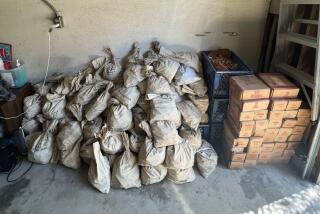Hunts Say They Sold 90% of Silver Hoard
DALLAS — One of the boldest and most costly attempts ever to corner the market in a precious metal appears to have wound up in a huge loss for the Hunt family of Texas. The family has sold off about 90% of its famed silver hoard, a spokesman said Thursday.
The Hunts’ audacious plan to corner the silver market, a bid that collapsed along with the metal’s prices in 1980, is ending as the sale helps “pay off debts and fund ongoing enterprises,” Hunt spokesman Tom Whitaker said.
Over the last several months, the Hunts quietly but steadily have sold chunks of the 59 million ounces of silver that they accumulated in the late 1970s, Whitaker said.
The sale “was in an orderly fashion through regular market channels,” he said. “There is no imperative need or immediate plans to dispose of the rest of the silver, and it will be dealt with over a period of time in a normal business manner.”
The Hunts lost about $1 billion speculating on silver futures contracts in 1980, and the Wall Street Journal estimated that the latest sales represent a loss of about $1 billion, largely interest costs on loans used to finance the cache.
Whitaker declined to fix a price on the losses, saying only that “obviously, the loss has had an impact on business operations. But we weathered the storm pretty well, and things look bright for the future.”
But the Journal said that, since 1980, the combined wealth of the three brothers--Nelson Bunker Hunt, W. Herbert Hunt and Lamar Hunt--has plummeted to an estimated $2 billion from the $5 billion to $6 billion that they claimed in 1980.
Whitaker did note that the Hunts’ Placid Oil Co., which controls the silver cache, will have a debt of $775 million by year-end, compared to $825 million a month ago.
The substantial silver sales have not sent the market into a spin as the silver price has held relatively steady all year at about $6 per ounce. By comparison, that price ranged from $18 to $20 per ounce in late 1979 and reached about $50 per ounce before collapsing in 1980.
But “now that the selling pressure is off, we expect silver prices to go up about $2 in a few weeks’ time,” said G. Michael Boswell, president of Dallas-based Sunshine Mining Co.
Bankers told the Journal that the Hunts may have been moved to sell the silver by a 1980 agreement with the Federal Reserve Board, which required them to dispose of their silver holdings in an “orderly fashion” by about 1990.
More to Read
Inside the business of entertainment
The Wide Shot brings you news, analysis and insights on everything from streaming wars to production — and what it all means for the future.
You may occasionally receive promotional content from the Los Angeles Times.










